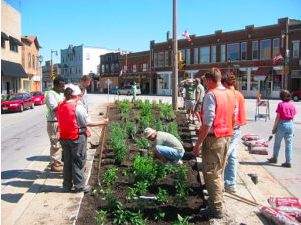Meaningful participation in urban ecosystem-based adaptation – how can it work?

This weADAPT article is an abridged version of the original blog, which can be downloaded from PlanAdapt’s website where it was originally published on the 22nd August 2022: ‘Meaningful Participation in Urban Ecosystem-based Adaptation – How Can it Work?’. Please access the original text for more detail, research purposes, full references, or to quote text.
What is urban ecosystem-based adaptation?
Ecosystem-based adaptation (EbA) describes methods of ‘working with nature’ to produce goods and services that reduce human and ecosystem vulnerability to climate change. For a project to qualify as EbA, it should advance climate justice, by supporting ‘equitable governance’ and enhancing ‘capacities’ (FEBA, 2017). In a context of Urban EbA, the social principle, ‘participation and inclusiveness’, helps to ensure that EbA is equitable.This is one of 7 social principles, identified to advance climate justice; the remaining 6 are: capacity building, fairness and equitability, gender consideration, livelihood improvement, appropriateness of scale and integration of intergenerational knowledge (Vidal Merino et al.,2021).
For a project to meet the social principle of participation, it should ‘be designed, developed and implemented involving local stakeholders, particularly historically marginalised groups, via participatory methods. Actively engaging cross-disciplinary stakeholders aims to ensure transparent, accountable, culturally appropriate and equitable outcomes’ (ibid.).
Which approaches foster participation?
Participation can be designed into projects using motivational approaches, including:
-
Financial Incentives –In the Páramos Conservation Corridor Project,implemented by Conservation International in Bogotá, Colombia, community theatre was used to build trust with local, homeless stakeholders, and engage them in this creek restoration initiative. They could earn money by supporting activities run by this theatre.
-
Altruistic Motivation –The Green Seattle Partnership (GSP), a governmental collaboration with 54 volunteer-based partner organizations, aims to engage diverse stakeholders in restoring the city’s urban forests. Its updated strategic plan ensures that paid opportunities are allocated for minority and under-represented groups so these demographics see themselves as present within the partnership, and it offers training days on institutional racism.
-
Self-Help for Mental Well-being– In the Kayole Estate Transformation Project, 60-70 youth volunteers are active in creating green spaces for recreation. This community-based project is motivated by local people’s desire to have a natural space to unwind and relax after working in Nairobi city.
-
Material Recompense– In the Rain Forests People project,co-implemented by the International Rainwater Harvesting Alliance and APAF-Senegal, village members in the rural communes of Loul Sessène and Djilasse were involved in participatory mapping as a first phase of EbA implementation. The financial benefits of agroforestry and rainwater harvesting were demonstrated to these communities, with 70 farming families enjoying improved, domestic water supply and drinking water quality and increased farming yields.
Refer to the full blog post to explore these examples in more detail.
How is participation discussed at the Nature of Cities Festival?
At the Nature of Cities Festival 2022, in a session discussing Urban EbA, attendees were invited to discuss the principle of participation and inclusiveness. The question – what constitutes meaningful participation? – shaped the conversation.
The following points were observed regarding long-term processes of participation:
- Funding is necessary to allocate time and resources for local NGOs and local authorities to build trust and meaningful collaborative practices with local community members.
- This can involve including local communities in project design, using processes of participatory mapping.
- Resources are also necessary to enable participants to communicate with each other and with local NGOs during the project implementation phase.
Clearly signposting how participants can benefit from engaging with EbA and identifying what specific adaption outcomes are desired by diverse community-members, then, remains a key point of focus in any Urban EbA participatory process that furthers climate justice.
Suggested Citation:
Nisbet, R., Tuhkanen, H. and Hofemeier, A. (2022). ‘Meaningful participation in urban ecosystem-based adaptation – how can it work?’. Available at: https://www.plan-adapt.org/2022/08/25/meaningful-participation-in-urban-ecosystem-based-adaptation-how-can-it-work/
(0) Comments
There is no content